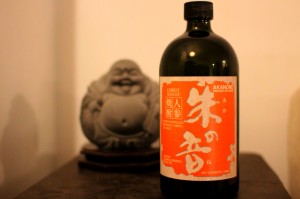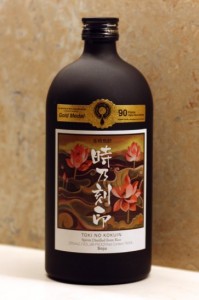kome
Beniotome claims to be the only spirit in the world distilled from sesame seeds. This is probably true, because, of course, sesame seeds don't hold a lot of sugar. Fortunately for us, the seeds are not the primary distillate - barley and rice in the mash provide the sugars (and alcohol) while the roasted sesame seeds provide a completely unique drinking experience.
Akanone Carrot Shochu
Distilled carrots? What will the Japanese think of next? Don't let the gimmicky notion get in the way here. This is a legit gem. Quickly becoming one of my favorite shochus.
Private Shochu Tasting
Good friends of ours were kind enough to make Cioppino for us on our last night in LA. We repaid them with an impromptu shochu tasting from the bottles we had to leave behind.
Far left is Kagura Tensho, which we just reviewed. A nice, smooth soba, barley, and rice shochu.
Far right is an Awamori we reviewed last week, Shimauta.
Next to the Shimauta is my new favorie imo, Kurokame, our first 90+ point shochu.
But what’s that 4th bottle? It’s a mystery. Anyone know? We’ll reveal it soon.
What was the consensus? For our friends who are not familiar with shochu, they were struck by the complexity and variation in just 4 bottles of what is arguably the same spirit.… Read More “Private Shochu Tasting”
Triple Threat: Kagura Tensho
Kagura Tensho is the first 3 grain shochu we’ve reviewed. Barley and rice shochus tend to rely on the single grain while imo (sweet potato) shochus combine with rice or more rarely with barley to balance the robust earthiness of the sweet potatoes. However, this is the first shochu we’ve found that uses three different grains. The usual suspects, rice and barley, are joined with soba, or buckwheat, a heartier grain used in making soba noodles.
Toki No Kokuin
Toki No Kokuin is an award winning shochu, reciving a Gold Medal at the 2009 World Wine Championships. This reflects, no doubt, the extremely neutral and easy-drinking nature of the spirit. This pure rice shochu is very easy drinking despite aging for 3 years in oak barrels. While there is very little English language information avialable, my guess is that these are virgin oak barrels as there is no hint of any other oak-aged spirit in the flavor.
Bunzo Kome
Bunzo Kome is a polished rice shochu, which, as with other shochus of this style, results in a sweet, mellow drink. There is a light, neutral, slightly alcoholic nose – not much going on at all with the scent of this shochu. The flavor is a sweet first impression, not unlike some sake, and that’s followed by more sweetness – a mellow sweetness. Not quite sugar, but not molasses or honey either.






